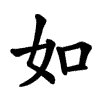Definify.com
Definition 2025
乙
乙
| ||||||
|---|---|---|---|---|---|---|
See also: 之
Translingual
| Stroke order | |||
|---|---|---|---|

| |||
Original form of 鳦 (swallow). Current meaning by phonetic loan.
Han character
乙 (radical 5 乙+0, 1 stroke, cangjie input 弓山 (NU), four-corner 17710)
- the second of the ten heavenly stems
- second
- Kangxi radical #5, ⼄ (“second”).
- the quantity 1
Derived characters
References
- KangXi: page 83, character 15
- Dai Kanwa Jiten: character 161
- Dae Jaweon: page 167, character 7
- Hanyu Da Zidian: volume 1, page 47, character 4
- Unihan data for U+4E59
- “乙”, in 字源 (in Mandarin), accessed 2014-03-21
Chinese
|
simp. and trad. |
乙 | |
|---|---|---|
Pronunciation
- Mandarin
- Cantonese (Jyutping): jyut3, jyut6
- Hakka (Sixian, PFS): yet / yat
- Min Nan (POJ): it
- Wu (Wiktionary): iq (T4)
- Mandarin
- (Standard Chinese, Beijing)+
- Pinyin:
- Zhuyin: ㄧˇ
- Wade-Giles: i3
- Gwoyeu Romatzyh: yii
- IPA (key): /i²¹⁴/
- (Standard Chinese, Beijing)+
- Cantonese
- (Standard Cantonese, Guangzhou)+
- Jyutping: jyut3, jyut6
- Yale: yut, yuht
- Cantonese Pinyin: jyt8, jyt9
- IPA (key): /jyːt̚³/, /jyːt̚²/
- (Standard Cantonese, Guangzhou)+
- Hakka
- (Northern Sixian, incl. Miaoli)
- Pha̍k-fa-sṳ: yet
- Hakka Romanization System: ied`
- Hagfa Pinyim: yad5
- IPA: /i̯et̚²/
- (Southern Sixian, incl. Meinong)
- Pha̍k-fa-sṳ: yat
- Hakka Romanization System: (r)iad`
- Hagfa Pinyim: yad5
- IPA: /(j)i̯at̚²/
- (Northern Sixian, incl. Miaoli)
- Min Nan
- (Hokkien)
- Pe̍h-ōe-jī: it
- Tâi-lô: it
- Phofsit Daibuun: id
- IPA (Xiamen): /it̚³²/
- IPA (Quanzhou): /it̚⁵/
- IPA (Zhangzhou): /it̚³²/
- IPA (Taipei): /it̚³²/
- IPA (Kaohsiung): /it̚³²/
- (Hokkien)
- Wu
- (Shanghainese)
- Wiktionary: iq (T4)
- IPA (key): /i̯ɪʔ⁵⁵/
- (Shanghainese)
| Rime | |
|---|---|
| Character | 乙 |
| Reading # | 1/1 |
| Initial (聲) | 影 (34) |
| Final (韻) | 質 (49) |
| Tone (調) | Checked (Ø) |
| Openness (開合) | Open |
| Division (等) | Chongniu III |
| Fanqie | 於筆切 |
| Reconstructions | |
| Zhengzhang Shangfang |
/ʔˠiɪt̚/ |
| Pan Wuyun |
/ʔᵚit̚/ |
| Shao Rongfen |
/ʔiet̚/ |
| Edwin Pulleyblank |
/ʔjit̚/ |
| Li Rong |
/ʔjĕt̚/ |
| Wang Li |
/ĭĕt̚/ |
| Bernard Karlgren |
/ʔi̯ĕt̚/ |
| Expected Mandarin Reflex |
yi |
| Baxter-Sagart system 1.1 (2014) | |
|---|---|
| Character | 乙 |
| Reading # | 1/1 |
| Modern Beijing (Pinyin) |
yǐ |
| Middle Chinese |
‹ ʔit › |
| Old Chinese |
/*qrət/ |
| English | 2nd heavenly stem |
Notes for Old Chinese notations in the Baxter-Sagart system: * Parentheses "()" indicate uncertain presence; | |
| Zhengzhang system (2003) | |
|---|---|
| Character | 乙 |
| Reading # | 1/1 |
| No. | 14921 |
| Phonetic component |
乙 |
| Rime group |
質 |
| Rime subdivision |
2 |
| Corresponding MC rime |
乙 |
| Old Chinese |
/*qriɡ/ |
| Notes | 甲乙字收ɡ尾與燕乙字收d尾小分部有異 |
Noun
乙
- second, 2, B, II, beta (used for unnamed people or object, to enumarate headings in a list, for grade)
- (chemistry) ethyl
Proper noun
乙
- The second of the ten heavenly stems (天干 (tiāngān))
- Kangxi radical 5 (second)
- the seventh scale degree in Gongche musical notation (工尺譜/工尺谱 (gōngchěpǔ))
Number
乙
See also
- 天干 (tiāngān) The Heavenly Stems.
- 工尺譜/工尺谱 (gōngchěpǔ) The Gongche notation
-
 Kangxi radical on Wikipedia.Wikipedia
Kangxi radical on Wikipedia.Wikipedia
Pronunciation
- Mandarin
- (Standard Chinese, Beijing)+
- Pinyin:
- Zhuyin: ㄓㄜˊ
- Wade-Giles: chê2
- Gwoyeu Romatzyh: jer
- IPA (key): /ʈ͡ʂɤ³⁵/
- (Standard Chinese, Beijing)+
Proper noun
乙
- (Chinese calligraphy) turning stroke
See also
-
 Chinese strokes on Wikipedia.Wikipedia
Chinese strokes on Wikipedia.Wikipedia
References
- “乙”, in MDBG English to Chinese dictionary (based on CC-CEDICT) (in Mandarin/English), accessed 2014-02-13
- “Jukuu”, in Jukuu (in Mandarin/English), accessed 2014-03-21
Japanese
Kanji
乙
Readings
Compounds
Adjectival noun
乙 (-na inflection, hiragana おつ, romaji otsu)
- strange
- interestingly strange, spicy
Inflection
Inflection of "乙な"
| Stem forms | |||
|---|---|---|---|
| Imperfective (未然形) | 乙だろ | おつだろ | otsu daro |
| Continuative (連用形) | 乙で | おつで | otsu de |
| Terminal (終止形) | 乙だ | おつだ | otsu da |
| Attributive (連体形) | 乙な | おつな | otsu na |
| Hypothetical (仮定形) | 乙なら | おつなら | otsu nara |
| Imperative (命令形) | 乙であれ | おつであれ | otsu de are |
| Key constructions | |||
| Informal negative | 乙ではない 乙じゃない |
おつではない おつじゃない |
otsu de wa nai otsu ja nai |
| Informal past | 乙だった | おつだった | otsu datta |
| Informal negative past | 乙ではなかった 乙じゃなかった |
おつではなかった おつじゃなかった |
otsu de wa nakatta otsu ja nakatta |
| Formal | 乙です | おつです | otsu desu |
| Formal negative | 乙ではありません 乙じゃありません |
おつではありません おつじゃありません |
otsu de wa arimasen otsu ja arimasen |
| Formal past | 乙でした | おつでした | otsu deshita |
| Formal negative past | 乙ではありませんでした 乙じゃありませんでした |
おつではありませんでした おつじゃありませんでした |
otsu de wa arimasen deshita otsu ja arimasen deshita |
| Conjunctive | 乙で | おつで | otsu de |
| Conditional | 乙なら(ば) | おつなら(ば) | otsu nara (ba) |
| Provisional | 乙だったら | おつだったら | otsu dattara |
| Volitional | 乙だろう | おつだろう | otsu darō |
| Adverbial | 乙に | おつに | otsu ni |
| Degree | 乙さ | おつさ | otsusa |
Noun
乙 (hiragana きのと, romaji kinoto)
Interjection
- (Internet slang) Abbreviation of お疲れ様です (otsukaresama desu).
Derived terms
- うぽつ (upotsu), うp乙 (upotsu)
Korean
Hanja
乙 • (eul)
Eumhun:
- Sound (hangeul): 을 (revised: eul, McCune-Reischauer: ŭl)
- Name (hangeul): 새 (revised: sae, McCune-Reischauer: sae)
- This term needs a translation to English. Please help out and add a translation, then remove the text
{{rfdef}}.


















































































































































